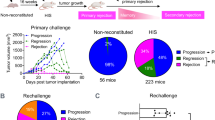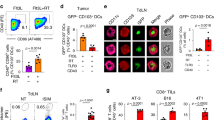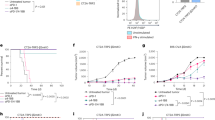Abstract
Cancer cells can evade immune recognition by losing major histocompatibility complex (MHC) class I. Hence, MHC class I-negative cancers represent the most challenging cancers to treat. Chemotherapeutic drugs not only directly kill tumors but also modulate the tumor immune microenvironment. However, it remains unknown whether chemotherapy-treated cancer cells can activate CD8 T cells independent of tumor-derived MHC class I and whether such MHC class I-independent CD8 T-cell activation can be exploited for cancer immunotherapy. Here, we showed that chemotherapy-treated cancer cells directly activated CD8 T cells in an MHC class I-independent manner and that these activated CD8 T cells exhibit virtual memory (VM) phenotypes. Consistently, in vivo chemotherapeutic treatment preferentially increased tumor-infiltrating VM CD8 T cells. Mechanistically, MHC class I-independent activation of CD8 T cells requires cell–cell contact and activation of the PI3K pathway. VM CD8 T cells contribute to a superior therapeutic effect on MHC class I-deficient tumors. Using humanized mouse models or primary human CD8 T cells, we also demonstrated that chemotherapy-treated human lymphomas activated VM CD8 T cells independent of tumor-derived MHC class I. In conclusion, CD8 T cells can be directly activated in an MHC class I-independent manner by chemotherapy-treated cancers, and these activated CD8 T cells may be exploited for developing new strategies to treat MHC class I-deficient cancers.
This is a preview of subscription content, access via your institution
Access options
Subscribe to this journal
Receive 12 digital issues and online access to articles
$119.00 per year
only $9.92 per issue
Buy this article
- Purchase on Springer Link
- Instant access to full article PDF
Prices may be subject to local taxes which are calculated during checkout






Similar content being viewed by others
References
Garrido, F., Aptsiauri, N., Doorduijn, E. M., Lora, A. M. G. & van Hall, T. The urgent need to recover MHC class I in cancers for effective immunotherapy. Curr. Opin. Immunol. 39, 44–51 (2016).
Haworth, K. B. et al. Going back to class I: MHC and immunotherapies for childhood cancer. Pediatr. Blood Cancer 62, 571–576 (2015).
Wang, X. et al. Histone deacetylase inhibition sensitizes PD1 blockade-resistant B-cell lymphomas. Cancer Immunol. Res. 7, 1318–1331 (2019).
Rosenwald, A. et al. The use of molecular profiling to predict survival after chemotherapy for diffuse large-B-cell lymphoma. N. Engl. J. Med. 346, 1937–1947 (2002).
Rooney, M. S., Shukla, S. A., Wu, C. J., Getz, G. & Hacohen, N. Molecular and genetic properties of tumors associated with local immune cytolytic activity. Cell 160, 48–61 (2015).
Roberts, R. A. et al. Loss of major histocompatibility class II gene and protein expression in primary mediastinal large B-cell lymphoma is highly coordinated and related to poor patient survival. Blood 108, 311–318 (2006).
Rimsza, L. M. et al. Loss of MHC class II gene and protein expression in diffuse large B-cell lymphoma is related to decreased tumor immunosurveillance and poor patient survival regardless of other prognostic factors: a follow-up study from the Leukemia and Lymphoma Molecular Profiling Project. Blood 103, 4251–4258 (2004).
Rimsza, L. M. et al. Loss of maj or histocompatibility class II expression in non-immune-privileged site diffuse large B-cell lymphoma is highly coordinated and not due to chromosomal deletions. Blood 107, 1101–1107 (2006).
Rimsza, L. M. et al. Gene expression predicts overall survival in paraffin-embedded tissues of diffuse large B-cell lymphoma treated with R-CHOP. Blood 112, 3425–3433 (2008).
Lawrence, M. S. et al. Discovery and saturation analysis of cancer genes across 21 tumour types. Nature 505, 495–501 (2014).
Garrido, F., Cabrera, T. & Aptsiauri, N. “Hard” and “soft” lesions underlying the HLA Class I alterations in cancer cells: implications for immunotherapy. Int J. Cancer 127, 249–256 (2010).
Diepstra, A. et al. HLA class II expression by Hodgkin Reed-Sternberg cells is an independent prognostic factor in classical Hodgkin’s lymphoma. J. Clin. Oncol. 25, 3101–3108 (2007).
Challa-Malladi, M. et al. Combined genetic inactivation of beta2-Microglobulin and CD58 reveals frequent escape from immune recognition in diffuse large B cell lymphoma. Cancer Cell. 20, 728–740 (2011).
Campbell, J. D. et al. Distinct patterns of somatic genome alterations in lung adenocarcinomas and squamous cell carcinomas. Nat. Genet. 48, 607–616 (2016).
Turcotte, S. et al. Tumor MHC class I expression improves the prognostic value of T-cell density in resected colorectal liver metastases. Cancer Immunol. Res. 2, 530–537 (2014).
Simpson, J. A. et al. Intratumoral T cell infiltration, MHC class I and STAT1 as biomarkers of good prognosis in colorectal cancer. Gut 59, 926–933 (2010).
Bubenik, J. MHC class I down-regulation: tumour escape from immune surveillance? (review). Int. J. Oncol. 25, 487–491 (2004).
Bracci, L., Schiavoni, G., Sistigu, A. & Belardelli, F. Immune-based mechanisms of cytotoxic chemotherapy: implications for the design of novel and rationale-based combined treatments against cancer. Cell Death Differ. 21, 15–25 (2014).
Mattarollo, S. R. et al. Pivotal role of innate and adaptive immunity in anthracycline chemotherapy of established tumors. Cancer Res. 71, 4809–4820 (2011).
Pfirschke, C. et al. Immunogenic chemotherapy sensitizes tumors to checkpoint blockade therapy. Immunity 44, 343–354 (2016).
Kroemer, G., Galluzzi, L., Kepp, O. & Zitvogel, L. Immunogenic cell death in cancer therapy. Annu Rev. Immunol. 31, 51–72 (2013).
Galluzzi, L., Buqué, A., Kepp, O., Zitvogel, L. & Kroemer, G. Immunogenic cell death in cancer and infectious disease. Nat. Rev. Immunol. 17, 97 (2017).
Denkert, C. et al. Tumor-associated lymphocytes as an independent predictor of response to neoadjuvant chemotherapy in breast cancer. J. Clin. Oncol. 28, 105–113 (2010).
de Kruijf, E. M. et al. The predictive value of HLA class I tumor cell expression and presence of intratumoral tregs for chemotherapy in patients with early breast cancer. Clin. Cancer Res. 16, 1272–1280 (2010).
Halama, N. et al. Localization and density of immune cells in the invasive margin of human colorectal cancer liver metastases are prognostic for response to chemotherapy. Cancer Res. 71, 5670–5677 (2011).
Zitvogel, L., Kepp, O. & Kroemer, G. Immune parameters affecting the efficacy of chemotherapeutic regimens. Nat. Rev. Clin. Oncol. 8, 151–160 (2011).
Roemer, M. G. et al. Classical Hodgkin lymphoma with reduced β2M/MHC class I expression is associated with inferior outcome independent of 9p24. 1 status. Cancer. Immunol. Res. 4, 910–916 (2016).
Schiavoni, G. et al. Cyclophosphamide induces type I interferon and augments the number of CD44(hi) T lymphocytes in mice: implications for strategies of chemoimmunotherapy of cancer. Blood 95, 2024–2030 (2000).
Carson, W. E., Shapiro, C. L., Crespin, T. R., Thornton, L. M. & Andersen, B. L. Cellular immunity in breast cancer patients completing taxane treatment. Clin. Cancer Res. 10, 3401–3409 (2004).
Dunn, G. P., Bruce, A. T., Ikeda, H., Old, L. J. & Schreiber, R. D. Cancer immunoediting: from immunosurveillance to tumor escape. Nat. Immunol. 3, 991–998 (2002).
Vesely, M. D., Kershaw, M. H., Schreiber, R. D. & Smyth, M. J. Natural innate and adaptive immunity to cancer. Annu. Rev. Immunol. 29, 235–71. (2011).
Lee, Y. J., Jameson, S. C. & Hogquist, K. A. Alternative memory in the CD8 T cell lineage. Trends Immunol. 32, 50–56 (2011).
White, J. T., Cross, E. W. & Kedl, R. M. Antigen-inexperienced memory CD8(+) T cells: where they come from and why we need them. Nat. Rev. Immunol. 17, 391–400 (2017).
Sosinowski, T. et al. CD8alpha+ dendritic cell trans presentation of IL-15 to naive CD8+ T cells produces antigen-inexperienced T cells in the periphery with memory phenotype and function. J. Immunol. 190, 1936–1947 (2013).
Haluszczak, C. et al. The antigen-specific CD8+ T cell repertoire in unimmunized mice includes memory phenotype cells bearing markers of homeostatic expansion. J. Exp. Med. 206, 435–448 (2009).
Lee, J. Y., Hamilton, S. E., Akue, A. D., Hogquist, K. A. & Jameson, S. C. Virtual memory CD8 T cells display unique functional properties. Proc. Natl Acad. Sci. USA 110, 13498–13503 (2013).
Akue, A. D., Lee, J. Y. & Jameson, S. C. Derivation and maintenance of virtual memory CD8 T cells. J. Immunol. 188, 2516–23. (2012).
Jacomet, F. et al. The hypothesis of the human iNKT/Innate CD8(+) T-cell axis applied to cancer: evidence for a deficiency in chronic myeloid leukemia. Front. Immunol. 7, 688 (2016).
Barbarin, A. et al. Phe notype of NK-like CD8(+) T cells with innate features in humans and their relevance in cancer diseases. Front. Immunol. 8, 316 (2017).
Lang, J., Weiss, N., Freed, B. M., Torres, R. M. & Pelanda, R. Generation of hematopoietic humanized mice in the newborn BALB/c-Rag2null Il2rgammanull mouse model: a multivariable optimization approach. Clin. Immunol. 140, 102–116 (2011).
Lang, J. et al. Studies of lymphocyte reconstitution in a humanized mouse model reveal a requirement of T cells for human B cell maturation. J. Immunol. 190, 2090–2101 (2013).
Lang, J. et al. Receptor editing and genetic variability in human autoreactive B cells. J. Exp. Med. 213, 93–108 (2016).
Lang, J. L. et al. Replacing mouse BAFF with human BAFF does not improve B-cell maturation in hematopoietic humanized mice. Blood Adv. 1, 2729–2741 (2017).
Kim, K. J., Kanellopoulos-Langevin, C., Merwin, R. M., Sachs, D. H. & Asofsky, R. Establishment and characterization of BALB/c lymphoma lines with B cell properties. J. Immunol. 122, 549–554 (1979).
Herz, J., Johnson, K. R. & McGavern, D. B. Therapeutic antiviral T cells noncytopathically clear persistently infected microglia after conversion into antigen-presenting cells. J. Exp. Med. 212, 1153–1169 (2015).
Wang, X. G. et al. Chemotherapy-induced differential cell cycle arrest in B-cell lymphomas affects their sensitivity to Wee1 inhibition. Haematologica 103, 466–476 (2018).
White, J. T. et al. Virtual memory T cells develop and mediate bystander protective immunity in an IL-15-dependent manner. Nat. Commun. 7, 11291 (2016).
Jacomet, F. et al. Evidence for eomesodermin-expressing innate-like CD8(+) KIR/NKG2A(+) T cells in human adults and cord blood samples. Eur. J. Immunol. 45, 1926–1933 (2015).
Zitvogel, L., Galluzzi, L., Smyth, M. J. & Kroemer, G. Mechanism of action of conventional and targeted anticancer therapies: reinstating immunosurveillance. Immunity 39, 74–88 (2013).
Galluzzi, L., Buque, A., Kepp, O., Zitvogel, L. & Kroemer, G. Immunological effects of conventional chemotherapy and targeted anticancer agents. Cancer Cell. 28, 690–714 (2015).
Lauvau, G. & Goriely, S. Memory CD8(+) T cells: orchestrators and key players of innate immunity? PLoS Pathog. 12, e1005722 (2016).
Renkema, K. et al. IL-4 sensitivity shapes the peripheral CD8+T cell pool and response to infection. J. Immunol. 213, 1319–1329 (2016).
Thommen, D. S. & Schumacher, T. N. T cell dysfunction in cancer. Cancer Cell. 33, 547–62. (2018).
Lam, A. R. et al. RAE1 ligands for the NKG2D receptor are regulated by STING-dependent DNA sensor pathways in lymphoma. Cancer Res. 74, 2193–2203 (2014).
Yang, J. et al. Targeting PI3K in cancer: mechanisms and advances in clinical trials. Mol. Cancer 18, 26 (2019).
Mensah, F. A., Blaize, J. P. & Bryan, L. J. Spotlight on copanlisib and its potential in the treatment of relapsed/refractory follicular lymphoma: evidence to date. Onco Targets Ther. 11, 4817–27. (2018).
Janku, F. Phosphoinositide 3-kinase (PI3K) pathway inhibitors in solid tumors: from laboratory to patients. Cancer Treat. Rev. 59, 93–101 (2017).
Graf, S. A. & Gopal, A. K. Idelalisib for the treatment of non-Hodgkin lymphoma. Expert Opin. Pharmacother. 17, 265–274 (2016).
Acknowledgements
We thank Dr. Julie Lang and Jeremy Shulman from the TRNPM facility for providing humanized BRGS mice and human peripheral blood samples and Alexandra Krinsky, Nicholas Rotello Kuri, and Kole Degolier for technical help. We apologize to those whose work was not cited due to length restrictions. This work was supported by University of Colorado School of Medicine and Cancer Center startup funds to JHW, Cancer League of Colorado grants R21-CA184707, R21-AI110777, R01-CA166325, R21-AI133110, and R01-CA229174 to J.H.W., and a fund from American Cancer Society (ACS IRG #16–184–56) to Z.C. X.W. was supported by an AAI Careers in Immunology Fellowship. R.A.W. is supported by an NIH F31 fellowship (F31DE027854). S.M.Y.C. is supported by an NIH T32 fellowship (T32 AI007405).
Author information
Authors and Affiliations
Contributions
J.H.W. was responsible for conceptualization, funding acquisition, supervision, project administration, and resources. X.W. and J.H.W. designed the experiments. X.W. performed most of the experiments with the help of B.C.W., R.A.W., S.M.Y.C., and Z.C., who are responsible for the investigation of the study. X.W., R.A.W. and J.H.W. wrote the paper.
Corresponding author
Ethics declarations
Competing interests
The authors declare no competing interests.
Supplementary information
Rights and permissions
About this article
Cite this article
Wang, X., Waschke, B.C., Woolaver, R.A. et al. MHC class I-independent activation of virtual memory CD8 T cells induced by chemotherapeutic agent-treated cancer cells. Cell Mol Immunol 18, 723–734 (2021). https://doi.org/10.1038/s41423-020-0463-2
Received:
Revised:
Accepted:
Published:
Issue Date:
DOI: https://doi.org/10.1038/s41423-020-0463-2
Keywords
This article is cited by
-
Targeting MHC-I molecules for cancer: function, mechanism, and therapeutic prospects
Molecular Cancer (2023)
-
A virtual memory CD8+ T cell-originated subset causes alopecia areata through innate-like cytotoxicity
Nature Immunology (2023)
-
Bacterial lipopolysaccharide related genes signature as potential biomarker for prognosis and immune treatment in gastric cancer
Scientific Reports (2023)
-
Chemotherapy brings virtual memory T cells into reality for cancer therapy
Cellular & Molecular Immunology (2021)
-
HLA class I loss in colorectal cancer: implications for immune escape and immunotherapy
Cellular & Molecular Immunology (2021)



